(more info added 1/23 – ed.)
You may recall that back in November something very strange happened: I passed other boats in a little Melonseed. More accurately, I passed all other boats in a Melonseed. And when I say passed, I don’t mean a little bit. I totally smoked em. I assure you, this rarest of phenomena was as baffling to me as it was irritating to the guys steering the other boats.
Let’s review what transpired:
In Caesura, I was the last to leave the docks (as always). This much is normal. But, almost immediately upon exiting the marina, I noticed this littlest of boats was catching up to the others, and very soon was passing them. Most unusual. In short order I was actually out in front. I kid you not when I say this never happens. I don’t even care about going fast! Wasn’t actually trying, which I think only made it more annoying to the people who, you know, like to be in front.
The lead continued, and lengthened. Within a single mile of travel I was half a mile ahead. Soon the lead stretched to over a mile, then two. Something weird was happening. Finally, I had to pull over into a cove and wait for the others.
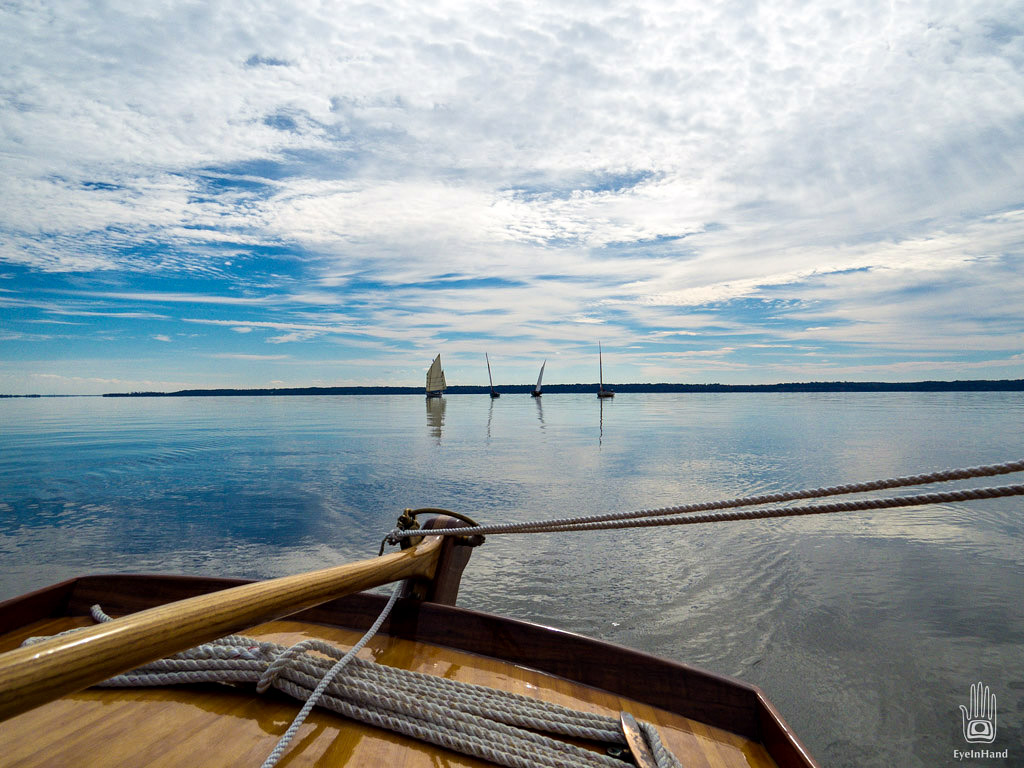 Ahead after less than a half mile.
Ahead after less than a half mile.
What was going on?
I spent a lot of time trying to figure this out, while I listened to the other fellows grumbling. I felt like the bumbling wizard in the balloon leaving OZ, not knowing why it’s floating away and unable to stop it. “I don’t know what’s happening!” I kept hollering. These were all much larger boats – some of them 40% longer – and all carrying two to three times as much sail as the little Melonseed. By standard laws of nautical design, longer boats, when not planing, go faster. Also, like cars with bigger engines, boats with bigger sails go faster. What we experienced was contrary to all the laws of nautical nature.
It was so still and quiet that day that across 100 yards of water I could clearly hear the mumblings and grumblings about topsails. I did have a tops’l up. Surely that helped some, but it’s so small the boost is marginal. Complaints aside, that alone doesn’t explain it. Nor could be, sad to say, superior seamanship.
I have a theory.
But first a few observations. Number one is the laws of naval design only hold true within a certain range of parameters. They don’t scale well; at least not down. Essentially, they are true for boats over a certain size, all displacement hulls, whether sail or engine powered. In this range the rules hold basically true for all practical purposes. But once you get outside that range – think anything less than a typical pleasure yacht or naval destroyer or tanker or cargo ship – the rules start to break down. They don’t apply to very small boats, or boats that plane.
By all the rules of naval engineering, all the other boats in the fleet should have pulled away from me at a steady, predictable pace – they are longer, carry more sail, and not that much heavier. That just didn’t happen.I know from my few classes in physics that fluid dynamics are incredibly complex, basically it’s chaos loosely contained. Most men, especially engineers, like to deal with absolutes. What they call LAWS in fluid dynamics are more like guidelines.
The first clue came as I was passing under the Route 5 bridge. It was fall, and leaves were, you know, falling. In my excitement at being uncharacteristically in the lead, I observed a dry leaf, perched lightly on the surface of the water, passing by me at about the same rate I had passed the other boats. It was just spinning about, barely even breaking the surface, and blithely drifted right on by. Hmmm.
Second, when we turned to go upwind, all my advantages disappeared. I had to work hard again just to keep up again.
Barry’s rules of boat speed #1: Deep water creates more resistance than water at the surface.
With me and all the gear inside, Caesura floats in about 3 inches of water. It will sail in 6 inches or less. She sits wide on the water, not deep. Sailing downwind in very light air, going with the tide and the centerboard raised, she was barely breaking the surface. The other boats, though bigger and longer and carrying more sail, are also heavier. Some have sharp bottom shapes or keels that dig deeper into the water. In light air, going downwind, this is a disadvantage. They have to move more water out of the way, deeper, to move forward faster than the water itself is moving. It takes more energy to do that – energy not available in the very light winds that day. On the other hand, Caesura, sitting lightly on the surface, only had to move a little bit of water, all of it near the surface, which, like the dry leaf, takes very little energy.
You only have to go a few inches below the surface of the water to make a very big difference in the energy required to move it. That’s why the laws of naval design essentially hold true for bigger boats – they don’t have to deal with anything so small it barely breaks the surface. Beyond a foot or more deep, which most boats exceed easily, things start to become more predictable.
Think of it this way: Sit on the beach and brush your hand across the sand. The grains move easily, spreading out across the surface and around your fingers. Wiggle your fingers and the sand barely resists. The grains move freely. But bury your hand to the wrist and try to wriggle your fingers or move your hand side to side – there is tremendous resistance, because you not only need to move the sand your fingers are touching, but all the sand above and beside it. A few inches below the surface, you have to move a LOT of sand to move any of it.
The same is true of water and boat hulls. The water in the top three inches of the surface can easily get out of the way of a small light boat. But just a few inches down and you suddenly need to move a lot of water, even for a narrow keel, to move at all. The trick to big boat speed is to move as little water as possible as short a distance as possible. Hence try to make keels that are deep also very thin.
This is why I lost all advantage going upwind. In that case, the water resistance actually provides footing or purchase for the boats to press against. They press sideways and the resistance of all that water prevents the boat from sliding downwind across the surface. There is less resistance from the water in front of the narrow keels. The boats move forward much like pressing down on an ice cube on a table – caught between two opposing forces, the wind and the water, it squirts forward where there’s less resistance. Meanwhile, Caesura, with only the lightest of grip on the slippery surface water, has a hard time achieving the same effect. Even with the centerboard full down to reach deeper, the hull itself offers no assistance. She would need a very deep and wide centerboard to compensate for the slippery hull riding on the surface.
All of this reminds me of another, very similar day and outcome. Back in 2008, soon after Tony Thatcher finished his Melonseed for his parents, he brought it to St. Michaels for MASCF. It was one of those pleasant, clear, light air days for the race on Saturday. He invited me along for the ride. Neither one of us had any illusions about winning, or even doing well – the math was not in our favor, as mentioned earlier. We just knew it would be a fine time on the water with a lot of pretty boats to look at.
We didn’t bother trying to get a good start, just stayed out of the way of the serious racers and took photos, enjoying the view. We talked and talked, not paying much attention. I remember the wind was so light I kept lifting the boom over my head, mostly to keep it out of the way, but this actually gave the slack sail a little shape, too. We talked some more.
After the last mark, on the downwind leg, about 100 yards from the finish, I’m looking back over Tony’s shoulder as we chatted away. I noticed there were some very earnest and angry looking fellows behind us who seemed to be working very hard. I looked around and said, “Hey Tony, I think we’re actually in front. We’re winning!” Clearly a surprise to both of us.
Even with the two of us in that little boat, she still drew so little water that – in that light air, downwind, on that day – we had a clear advantage over the bigger boats with deeper drafts.
The blue ribbon still hangs proudly, if discretely, in this parent’s house near St. Michaels.
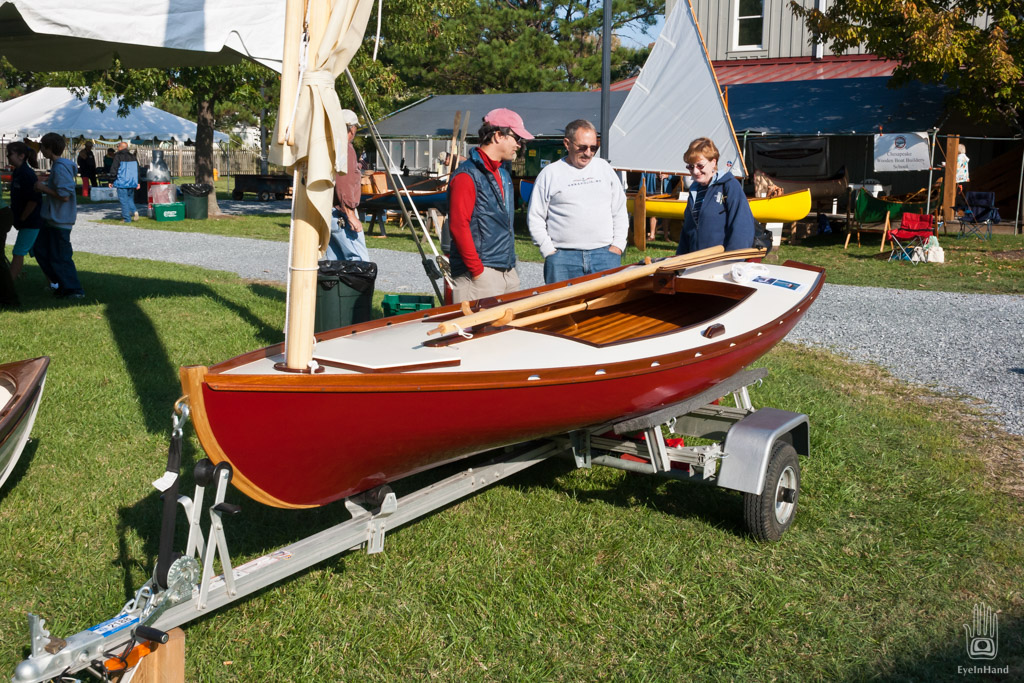 Tony with the Melonseed he built, in 2008.
Tony with the Melonseed he built, in 2008.
update 1/23/16
I’ve received several emails, in addition to comments here, since posting my heretic theories. Not to drag others into this discussion without their consent, but here are a couple of comments from people in the group of boats I’ve sailed with:
“In a good wind, everybody is going boat speed. It’s in light air that the real challenge starts.” – Pete Peters, whose Obadiah has the largest and lightest sail of all the Marsh Cats.
“When there’s no wind, the smallest and lightest boats have the advantage.” – Eddie Breeden, in his Sooty Tern Una, on the day we had no wind.
In response to Frank’s comment, wetted area is definitely a factor, as it translates directly to friction. I’ve received some emails supporting this theory. But I think there’s more to it than that. I tried sailing downwind with my board both up and down, and it made almost no measurable difference in boat speed, as measured with a GPS – maybe ¼ knot – though lowering the board would make an appreciable difference in wetted surface on such a small boat.
We all agree there are many factors that affect boat speed, but I believe they are not all equal under all conditions. There are at least dozens of different parameters, many of them in constant flux. At very low speeds in very light air, one set of factors predominate. In good wind, a different set becomes more important (theoretical hull speed, for example). In very strong winds in rough water, things like hull shape become more critical.
To test the idea I did my best to run some numbers, comparing the boats from that day as best I could. I can absolutely guarantee these numbers are not correct. The Sooty Tern numbers are especially suspect, because I had to cobble them together from different sources. But starting with the published specs I could find on all the boats, they should be incorrect across the board the same way, so relative differences are preserved, and it’s relative differences I’m looking for. Dennis’ Sharpie is not included in the numbers, since, as a custom design, the specs aren’t available. I’ve also thrown in the Lightning and the Blue Jay. Those boats weren’t there that day, but their sailing characteristics are so well known they provide a sort of control to check the validity of the numbers.
Here are the straight specs I’m working with, all measures converted to inches and pounds for easy comparison:
| Design | Length | Waterline | Beam | Weight | Sail Area | with Spin/Tops’l | Draft Up | Draft Down |
| Melonseed | 168 | 144 | 50 | 200 | 11376 | 79 | 3 | 28 |
| Marsh Cat | 180 | 168 | 83 | 1309 | 21888 | 9 | 29 | |
| Caledonia Yawl | 234 | 193 | 73 | 1090 | 23616 | 11 | 42 | |
| Sooty Tern | 237 | 193 | 64 | 1000 | 17280 | 11 | 42 | |
| Lightning | 228 | 183 | 78 | 700 | 25488 | 43200 | 5 | 59 |
| Blue Jay | 162 | 130 | 62 | 275 | 12960 | 21024 | 6 | 48 |
And here are photos of the boats. I tried to find similar images to help with visual comparisons of the hulls, waterlines, etc..
Let’s take the Sail Area to Wetted Surface ratio first. I used the measures of the Melonseed with the tops’l, since that was used on the day mentioned:
| Sail Area to Wetted Surface Ratio | |
| Melonseed | 16% |
| Marsh Cat | 14% |
| Caledonia Yawl | 15% |
| Sooty Tern | 13% |
| Lightning | 16% |
| Lightning w/ Spinnaker | 27% |
| Blue Jay | 14% |
| Blue Jay w/ Spinnaker | 23% |
You can see that there’s very little difference between the four boats sailing together that day. Just one or two percent. But calculating wetted surface is really inexact guesswork here. But even when I did the calculations using displacement and volume, and fudged figures to exaggerate the range, the differences were still 10% or less. In other words, in terms of wetted surface (friction) to sail power, these boats are all very similar. From this I conclude that wetted surface is not the controlling factor in play in light air, for these boats. Only the Lightning and Blue Jay, when flying spinnakers, show any significant difference, which is what you would expect.
But, when I compare the weight/displacement of these boats to sail area, some very big differences start to appear. These numbers use additional weight for crew on board that day:
| Boat Design | SqIn Sail Area | Weight w/Crew | SqIn Sail per Pound |
| Melonseed | 11376 | 400 | 28 |
| Marsh Cat | 21888 | 1509 | 15 |
| Caledonia Yawl | 23616 | 1490 | 16 |
| Sooty Tern | 17280 | 1200 | 14 |
| Lightning | 25488 | 1200 | 21 |
| Lightning Spinnaker | 43200 | 1200 | 36 |
| Blue Jay | 13104 | 675 | 19 |
| Blue Jay Spinnaker | 21024 | 675 | 31 |
Here we see a relative range that equate to the differences in speed we observed that day, downwind, in very light air. The Melonseed has roughly twice as much sail power per pound of Displacement as the other boats, which all are very similar to each other. This corresponds with what we saw happen.
Now, let’s look at something else. If we compare the Wetted Surface of each boat with its Displacement, something very surprising appears:
| SqIn Wetted Surface per Pound | |
| Melonseed | 15 |
| Marsh Cat | 8 |
| Caledonia Yawl | 9 |
| Sooty Tern | 9 |
| Lightning | 11 |
| Lightning w/ Spinnaker | 11 |
| Blue Jay | 11 |
| Blue Jay w/ Spinnaker | 11 |
Here you see the Melonseed, with it’s wide and flat bottom, has in some cases almost twice as much Wetted Surface per pound of Displacement as the other boats. If friction were a significant factor, the Melonseed should have been severely handicapped.
Now, look at the Draft
(with board up, the draft of the hull):
| Inches of Draft w/Board Up | |
| Melonseed | 3 |
| Marsh Cat | 9 |
| Caledonia Yawl | 11 |
| Sooty Tern | 11 |
| Lightning | 5 |
| Lightning w/ Spinnaker | 5 |
| Blue Jay | 6 |
| Blue Jay w/ Spinnaker | 6 |
What this means is the Melonseed, light and wide, sits only a few inches into the water. It has a lot of surface area for the volume of water it displaces. But it must displace far less water to move forward, per square inch of sail power, than any of the other boats, and all of that water is at the surface where it is displaced more easily.
In other words, in very light air – when no boats are going hull speed – the mass and inertia of the volume of water, that must be moved aside for a boat to move forward, is more significant than friction due to Wetted Surface, or the hull speed based on boat length.
True or not, this does at least correspond to what we all observed that day, mystifying as it was, same as the day Tony and I sailed his Melonseed at MASCF.
When we turned around, going into the light wind, all these advantages of a light boat vanish. At that point, the boats that can dig deeper into the water, and use its mass to their advantage, begin to pull ahead almost immediately. Even with the board down the light Melonseed can’t gain the traction needed to point as high as the others. It’s grip on the water against a headwind is not as strong, and it cannot use the power of the wind in the sail to full advantage, like the other designs. Note here, the extreme depth of the Lightning and the Blue Jay with their boards down, both high performance boats, when compared to the others. I expect the Lightning will do very well upwind, but be comparable to the others when going downwind without a spinnaker, maybe slower – the hard chine that digs in upwind and across it won’t be as slippery going downwind as smooth-hulled boats.
Wetted surface friction among boats of similar size is so similar it’s not statistically significant. However, displacement, hull shape, sail plan, and depth of keel among boats of similar size can each become very significant. On light air days, displacement to sail area is most significant. On heavier air days, waterline length is more significant. On a reach, a big sail with a broad heavy hull to make it stand up straight, like the Marsh Cat, does very well. Beating upwind, deep draft/keels with narrow entry is favored, especially when the wind is not strong enough to reach hull speed.
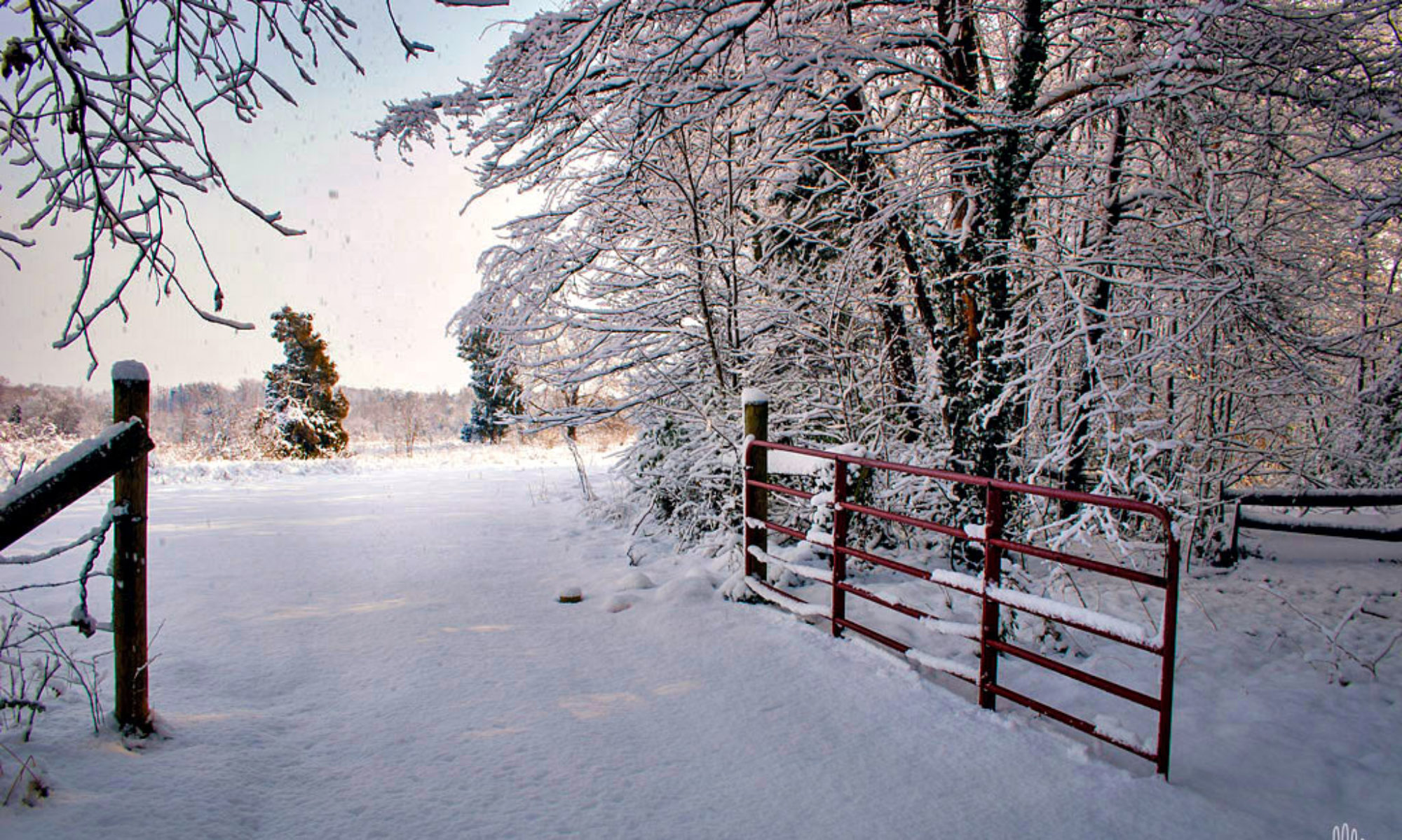

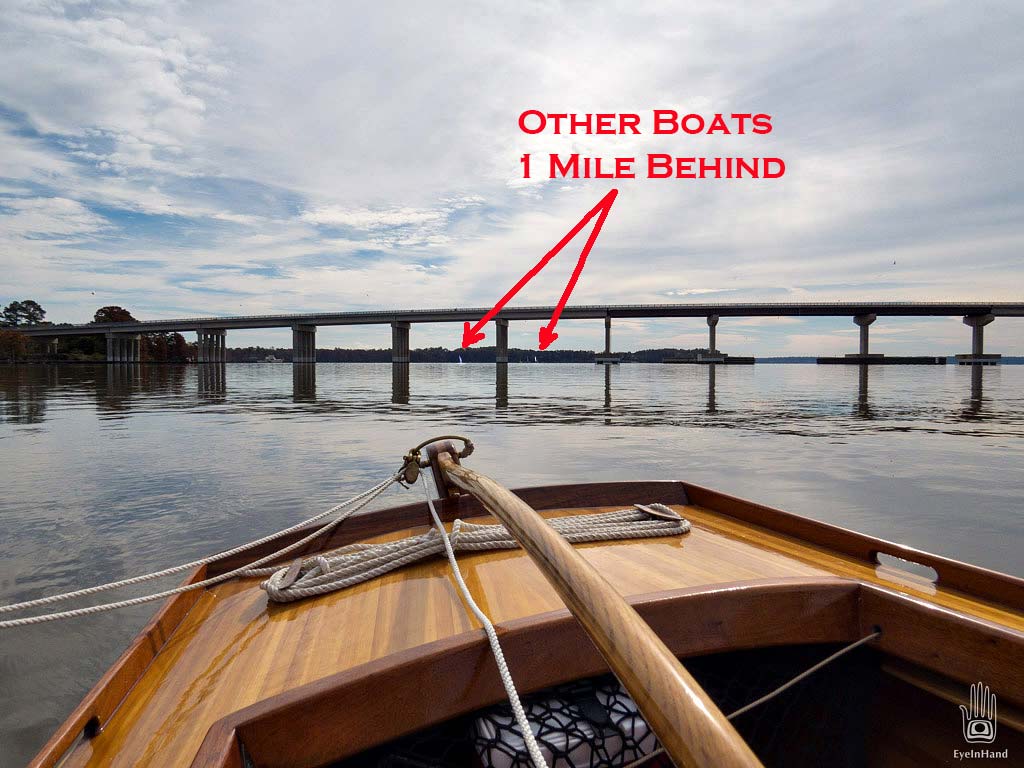
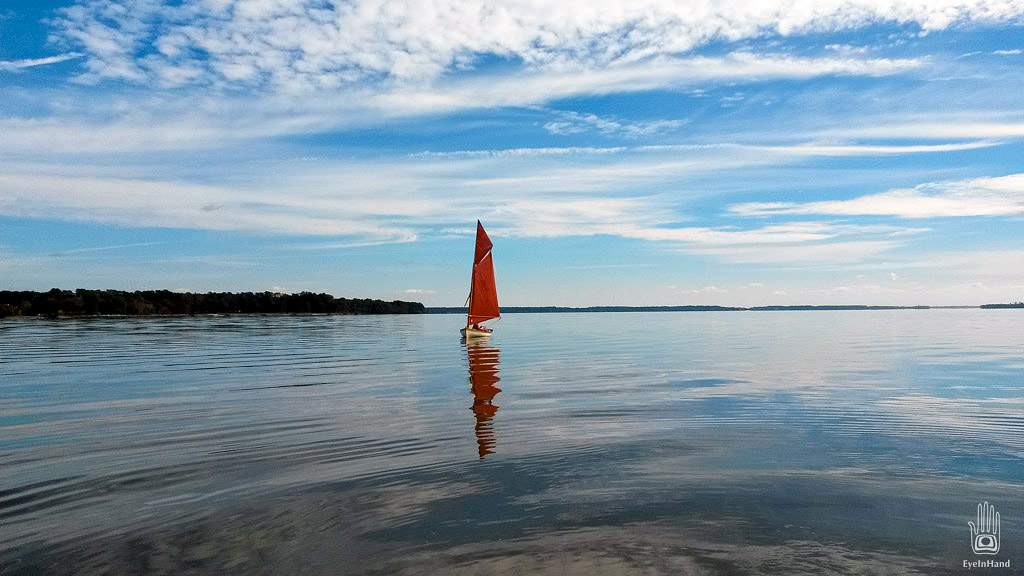




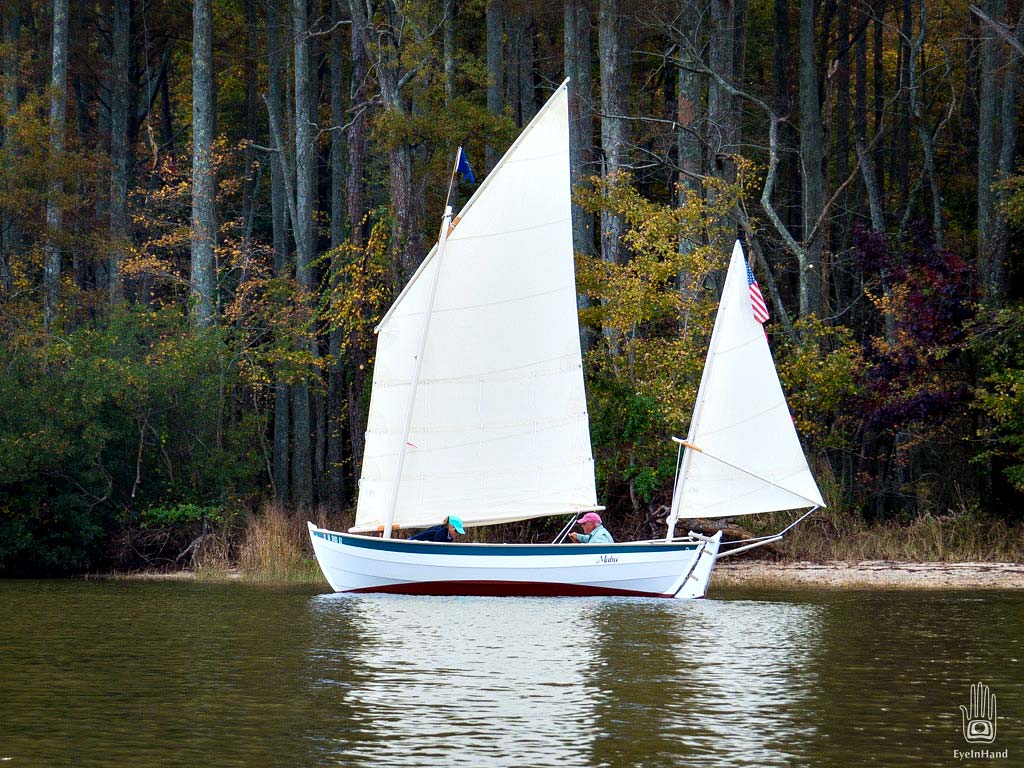
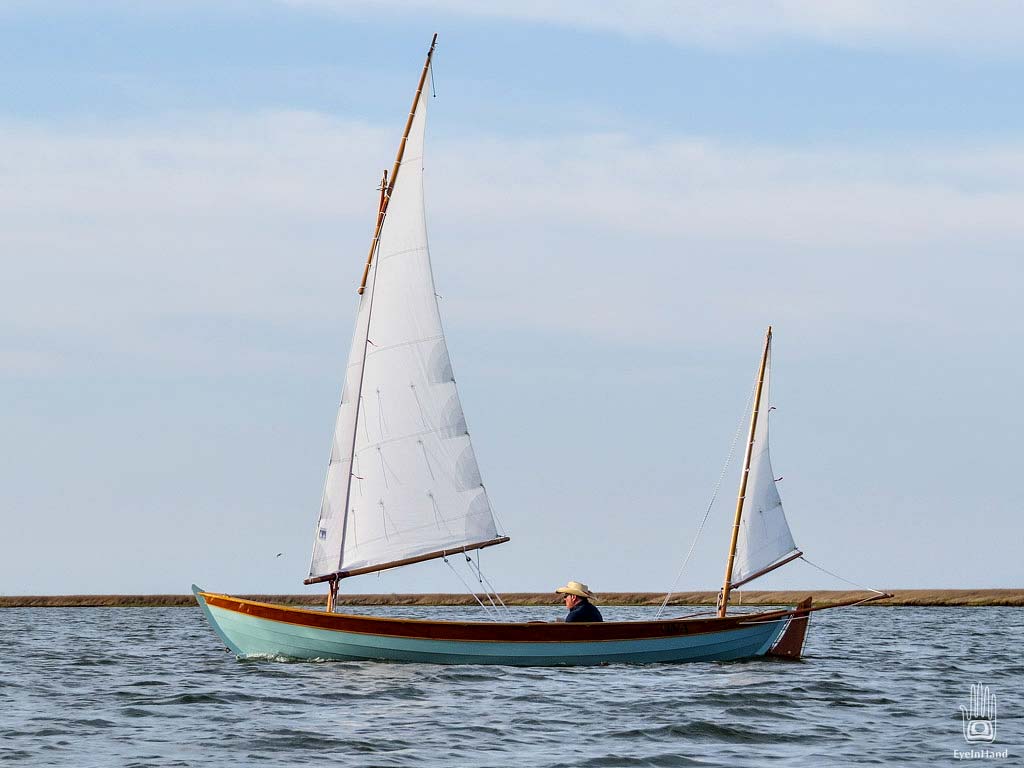
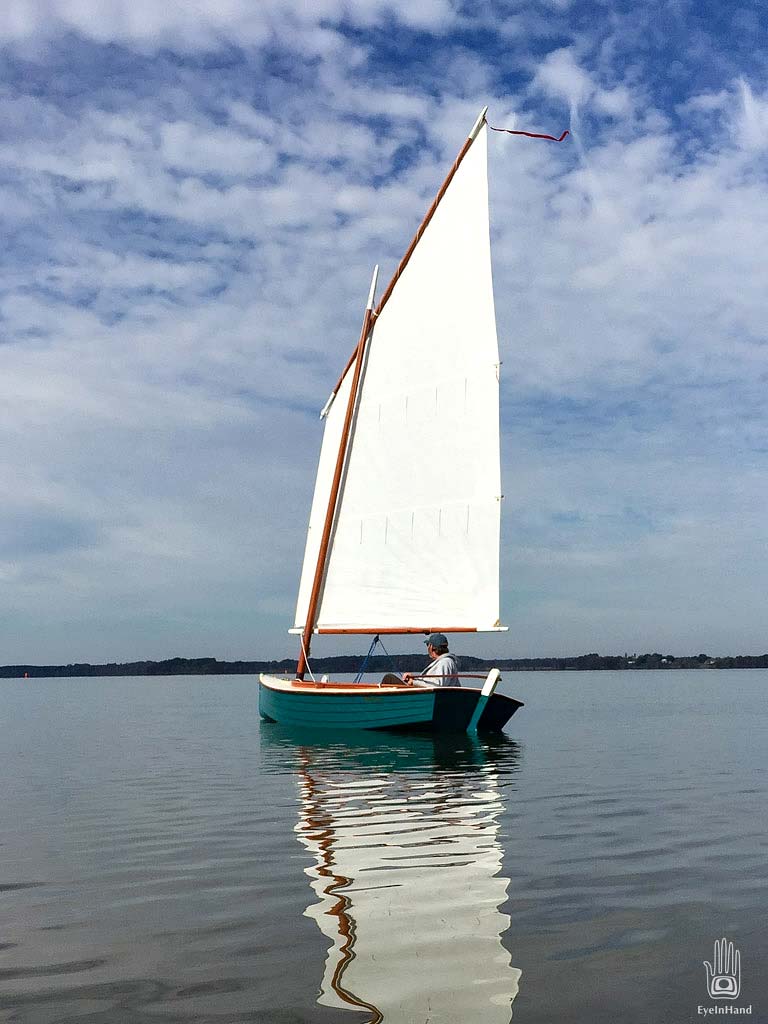
Sorry – but until the smallest boat becomes limited by it’s hull speed (which is a function of length) ALL boats of similar type would travel at the SAME SPEED!
Also unless there is a significant wind gradient favoring the higher rigs of the bigger boats.
Your sail area to wetted surface ratio being greater than the others favoured you until you had to drop your c/b to go to windward.
Laws of Naval Architecture ……
Kind regards,
Frank
Hi Frank,
What you say is of course correct, according to the math. The reason for this post is what we actually observed contradicted the math. We did NOT travel at the same speed, though the boats turn out to be more similar than not in most respects. Downwind, in light air, the smallest boat was going roughly twice as fast as the others, while the others were all very closely matched in speed.
See the additional notes appended for details.